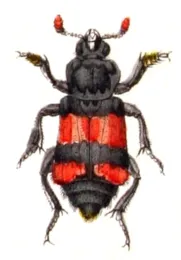
And with an exclamation point!
That's the theme of the Bohart Museum of Entomology open house, set from 1 to 4 p.m., Sunday, Jan. 22 in Room 1124 of the Academic Surge Building, 455 Crocker Lane, UC Davis campus.
It's free, family friendly and open to the public. Scientists will display scores of beetle species, ranging from burying beetles and darkling beetles to dung beetles and lady beetles (aka ladybugs).
Among the presenters will be Tracie Hayes, a doctoral student in the laboratory of Professor Louie Yang, UC Davis Department of Entomology and Nematology. She researches burying beetles, genus Nicrophorus, at the Bodega Marine Reserve. She will show a video she created, display specimens, and answer questions. Burying beetles, as the name implies, are known for burying the carcasses of small vertebrates, such as mice, squirrels and birds, and using them as a food source for their larvae. The American burying beetle, Nicrophorus americanus, endemic to North America, is a critically endangered species.
Folsom Lake College professor Fran Keller, a Bohart Museum scientist and a UC Davis doctoral alumna of entomology, will discuss the beetles she and other scientists collected in Belize.
"In November I started working in the Natural History Museum London Coleoptera collection, working on Belize Cerambycidae to facilitate identification and then catalog specimens for the Belize National Insect Collection," Keller said. "I worked with Larry Bezark, via the internet/email/Google Drive, who is retired from the California Department of Food and Agriculture. There were 28 new country records for Belize and two new species to science that Larry will describe."
Scientists from the California Department of Food and Agriculture also will be a key part of the open house.
Beetles, belonging to the order Coleoptera, the largest insect order, total some 400,000 species. They make up "about 40 percent of all insect species so far described, and about 25 percent of all animals," according to Wikipedia.
Beneficial beetles include the lady beetle, aka ladybug, which devours aphids and other small soft-bodied insects. Another beneficial beetle: the dung beetle, which feed on feces. Serious pests include the boll weevil, the Colorado potato beetle, the coconut hispine beetle, and the mountain pine beetle.
The family arts-and-crafts activity at the open house will be coloring a burying beetle, art that's the work of Tracie Hayes.
The Bohart Museum, dedicated to "understanding, documenting and communicating terrestrial arthropod diversity," is directed by Lynn Kimsey, UC Davis distinguished professor of entomology. Founded in 1946 and named for UC Davis professor and noted entomologist Richard Bohart, it houses a global collection of eight million insect specimens; a live "petting zoo," featuring Madagascar hissing cockroaches, walking sticks and tarantulas; and a year-around gift shop, stocked with insect-themed books, posters, jewelry, t-shirts, hoodies and more.
The museum is open to the public from 8 a.m. to noon, and 1 to 5 p.m., Mondays through Thursdays.

